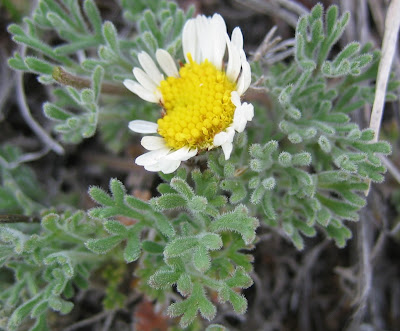There is still considerable snow at 7,000 feet or above, but the high prairie is really coming alive. As the line in Night Rider's Lament goes (click for version by Suzy Bogguss and Jerry Jeff Walker), when the cowboy considers why Easterners think him crazy for "roping the short pay" in the mountain West. His answer is (in part), "They've never seen Spring hit the Great Divide..." It is a gorgeous site to watch the prairie green up and then edge its way up into the hills and on up the mountainsides. Here's a little valley bottom covered with water as the mid-elevation snow melts off:

In moist corners like this of the upper Big Hole River prairie, the shooting stars are blooming. Both the violet Few Flowered Shooting Star (Dodecatheon pulchellum):

And a white species that I haven't been able to identify:

In an aspen stand just over the Divide, on the Clark Fork side, an Elk Thistle (Cirsium scariosum) pokes up from the moist duff:

Nearby, some moss comes alive from the water saturated ground:

As does the soft, scaly leaves of a Creeping Juniper (Juniperus horizontalis):

Yellow flowers of a cushion Drabas (Drabas spp.) brighten a dry, open hillside:

Out on the desert prairie of the lower Big Hole River, the Cushion Cactus (Coryphantha vivipara) are blooming singly [correction: these are Pediocactus simpsonii, common name Rocky Mountain Cactus or Mountain Ball Cactus -- see the comment from Tom (Czech Republic, below)]:

And in bunches:

On the rocks, the lichens too are brightening up:

Closer to home, the sagebrush steppe around Butte America is still recovering from the days when mining and smelting made the hills a barren waste. It is surprising how many species do quite well on the mine waste strewn and knapweed infested land, such as Cutleaf Daisy (Erigeron compositus):

Check out the close-up detail of this plant's beautiful, tiny finger-like leaf lobes:

Hood's Phlox (Phlox hoodii):

And colorful Rocky Mountain Douglasia (Douglasia montana):

Even quartz crystals left over as surface burden from the days of hardrock mining seem to come to life in the spring sun. No wonder people once thought crystals grew and bloomed in the earth like flowers:

While looking for flowers, I sat down awhile to see if the red fox would show herself. She dens in a gully behind the house near an old wrecked car:

Foxes have lived here for awhile, according to his old jaw bone:

I didn't see the fox that morning, but this Mountain Bluebird came by to visit:

As did this very handsome red-shafted Northern Flicker:

Wow! It pays to sit down and be still once in awhile--I might become a birder yet!

11 comments:
Excellent photos Pat! Canon said I should have my camera back next week with a warranty repair. Too many adventures for it. Feel lost without it.
ER,
Things are looking nice up north, especially your fine renditions of them. I love the cacti! Mountain bluebirds are one of my favorites. Enjoy your spring!
-scott c
Well that's one thing we have in common, ER----the Northern Flicker!!!!
You live in such an incredible area of the country. Have you always lived there??? I had some friends when I lived in Texas ---who moved to Montana to get away from the hustle and bustle of life in Texas.. I don't know where they went.. Wish I knew!
Have a great weekend.
Betsy
Great photos, and nice shot of the flicker. I have a succulent groundcover that looks very like the one with the tiny yellow flowers.
Outstanding. Flyfishing, hunting, skiing, hiking or even birding...whatever. Being tuned in to the natural world around us is what its all about. Thanks!
What marvelous photos. You truly live in a beautiful part of the world. Thanks for sharing it with us.
Great photos, ER! Several striking images here, all good.
:)
My my my such a grand series sharing the beauty of spring! Thank you for sharing.
ER: What super captures from the wild and natural sites.
Very nice! ..Make me dream about another trip tu US:)
PS: The cacti you your photos are not Coryphantha vivipara (which has very dissimilar flower) - you have seen Pediocactus simpsonii
Thank you, Tom, for the good correction. So noted! I see that the Coryphantha has much slimmer and more petals, whereas those of Pediocactus are fewer and wider. In looking at Google images, I also see that a lot of others have made this basic mistake.
Post a Comment